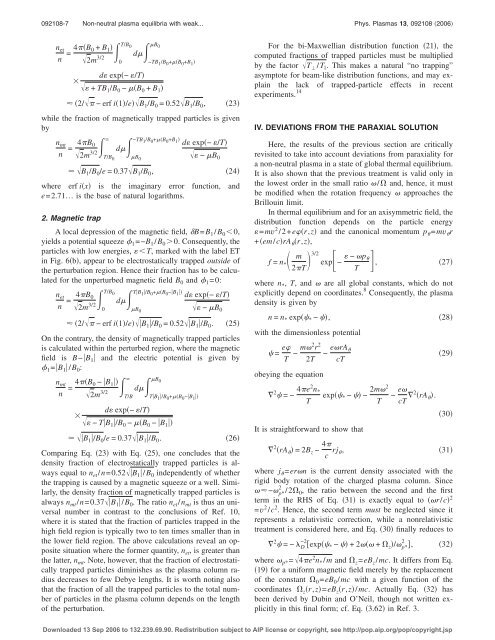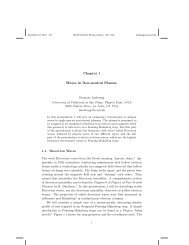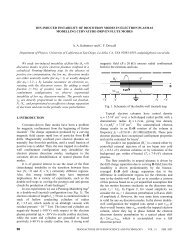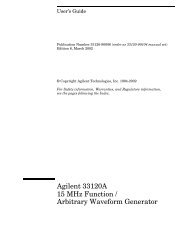Non-neutral plasma equilibria with weak axisymmetric magnetic ...
Non-neutral plasma equilibria with weak axisymmetric magnetic ...
Non-neutral plasma equilibria with weak axisymmetric magnetic ...
Create successful ePaper yourself
Turn your PDF publications into a flip-book with our unique Google optimized e-Paper software.
092108-7 <strong>Non</strong>-<strong>neutral</strong> <strong>plasma</strong> <strong>equilibria</strong> <strong>with</strong> <strong>weak</strong>... Phys. Plasmas 13, 092108 2006<br />
n et<br />
n = 4B 0 + B 1 <br />
2m<br />
3/2<br />
0<br />
T/B 0 B 0<br />
d −TB 1 /B 0 +B 0 +B 1 <br />
d exp− /T<br />
<br />
+ TB1 /B 0 − B 0 + B 1 <br />
2/ − erf i1/e B1 /B 0 = 0.52 B1 /B 0 ,<br />
23<br />
while the fraction of <strong>magnetic</strong>ally trapped particles is given<br />
by<br />
n mt<br />
n = 4B −TB 1 /B 0 +B 0 +B 1<br />
0<br />
d exp− /T<br />
2m<br />
3/2T/B 0<br />
dB 0<br />
− B0<br />
B1 /B 0 /e = 0.37 B1 /B 0 ,<br />
24<br />
where erf ix is the imaginary error function, and<br />
e=2.71... is the base of natural logarithms.<br />
2. Magnetic trap<br />
A local depression of the <strong>magnetic</strong> field, B=B 1 /B 0 0,<br />
yields a potential squeeze 1 =−B 1 /B 0 0. Consequently, the<br />
particles <strong>with</strong> low energies, T, marked <strong>with</strong> the label ET<br />
in Fig. 6b, appear to be electrostatically trapped outside of<br />
the perturbation region. Hence their fraction has to be calculated<br />
for the unperturbed <strong>magnetic</strong> field B 0 and 1 =0:<br />
n et<br />
n = 4B T/B 0 TB 1 /B 0 +B 0 −B 1<br />
0<br />
d exp− /T<br />
d<br />
2m<br />
3/20<br />
B 0<br />
− B0<br />
2/ − erf i1/e B1 /B 0 = 0.52 B1 /B 0 .<br />
25<br />
On the contrary, the density of <strong>magnetic</strong>ally trapped particles<br />
is calculated <strong>with</strong>in the perturbed region, where the <strong>magnetic</strong><br />
field is B−B 1 and the electric potential is given by<br />
1 =B 1 /B 0 :<br />
n mt<br />
n = 4B B<br />
0 − B 1 <br />
0<br />
2m<br />
3/2<br />
T/B<br />
dTB 1 /B 0 +B 0 −B 1 <br />
d exp− /T<br />
<br />
− TB1 /B 0 − B 0 − B 1 <br />
B1 /B 0 /e = 0.37 B1 /B 0 .<br />
26<br />
Comparing Eq. 23 <strong>with</strong> Eq. 25, one concludes that the<br />
density fraction of electrostatically trapped particles is always<br />
equal to n et /n=0.52 B1 /B 0 independently of whether<br />
the trapping is caused by a <strong>magnetic</strong> squeeze or a well. Similarly,<br />
the density fraction of <strong>magnetic</strong>ally trapped particles is<br />
always n mt /n=0.37 B1 /B 0 . The ratio n et /n mt is thus an universal<br />
number in contrast to the conclusions of Ref. 10,<br />
where it is stated that the fraction of particles trapped in the<br />
high field region is typically two to ten times smaller than in<br />
the lower field region. The above calculations reveal an opposite<br />
situation where the former quantity, n et , is greater than<br />
the latter, n mt . Note, however, that the fraction of electrostatically<br />
trapped particles diminishes as the <strong>plasma</strong> column radius<br />
decreases to few Debye lengths. It is worth noting also<br />
that the fraction of all the trapped particles to the total number<br />
of particles in the <strong>plasma</strong> column depends on the length<br />
of the perturbation.<br />
For the bi-Maxwellian distribution function 21, the<br />
computed fractions of trapped particles must be multiplied<br />
by the factor T /T . This makes a natural “no trapping”<br />
asymptote for beam-like distribution functions, and may explain<br />
the lack of trapped-particle effects in recent<br />
experiments. 14<br />
IV. DEVIATIONS FROM THE PARAXIAL SOLUTION<br />
Here, the results of the previous section are critically<br />
revisited to take into account deviations from paraxiality for<br />
a non-<strong>neutral</strong> <strong>plasma</strong> in a state of global thermal equilibrium.<br />
It is also shown that the previous treatment is valid only in<br />
the lowest order in the small ratio / and, hence, it must<br />
be modified when the rotation frequency approaches the<br />
Brillouin limit.<br />
In thermal equilibrium and for an <strong>axisymmetric</strong> field, the<br />
distribution function depends on the particle energy<br />
=mv 2 /2+er,z and the canonical momentum p =mv r<br />
+em/crA r,z,<br />
f = n * m<br />
3/2<br />
2T<br />
exp− − p <br />
T<br />
, 27<br />
where n * , T, and are all global constants, which do not<br />
explicitly depend on coordinates. 8 Consequently, the <strong>plasma</strong><br />
density is given by<br />
n = n * exp * − ,<br />
<strong>with</strong> the dimensionless potential<br />
= e T − m2 r 2<br />
2T<br />
− erA <br />
cT<br />
obeying the equation<br />
2 =− 4e2 n *<br />
T<br />
exp * − − 2m2<br />
T<br />
It is straightforward to show that<br />
2 rA =2B z − 4 c rj ,<br />
− e<br />
cT 2 rA .<br />
28<br />
29<br />
30<br />
31<br />
where j =ern is the current density associated <strong>with</strong> the<br />
rigid body rotation of the charged <strong>plasma</strong> column. Since<br />
− 2 p* /2 0 , the ratio between the second and the first<br />
term in the RHS of Eq. 31 is exactly equal to r/c 2<br />
=v 2 /c 2 . Hence, the second term must be neglected since it<br />
represents a relativistic correction, while a nonrelativistic<br />
treatment is considered here, and Eq. 30 finally reduces to<br />
2 =− −2 D exp * − +2 + z / 2 p* , 32<br />
where p* = 4e 2 n * /m and z =eB z /mc. It differs from Eq.<br />
19 for a uniform <strong>magnetic</strong> field merely by the replacement<br />
of the constant 0 =eB 0 /mc <strong>with</strong> a given function of the<br />
coordinates z r,z=eB z r,z/mc. Actually Eq. 32 has<br />
been derived by Dubin and O’Neil, though not written explicitly<br />
in this final form; cf. Eq. 3.62 in Ref. 3.<br />
Downloaded 13 Sep 2006 to 132.239.69.90. Redistribution subject to AIP license or copyright, see http://pop.aip.org/pop/copyright.jsp








![WORKSHOP PARTICIPANTS LIST [pdf] - UC San Diego](https://img.yumpu.com/35298899/1/190x245/workshop-participants-list-pdf-uc-san-diego.jpg?quality=85)
